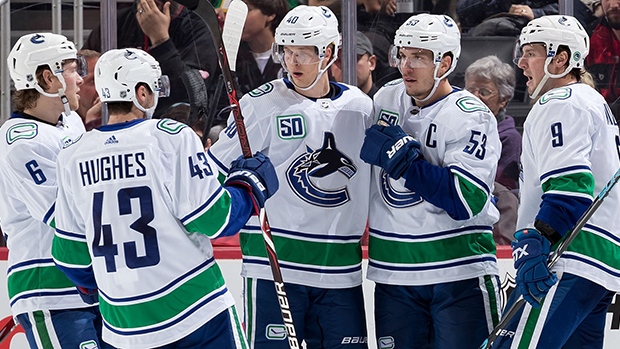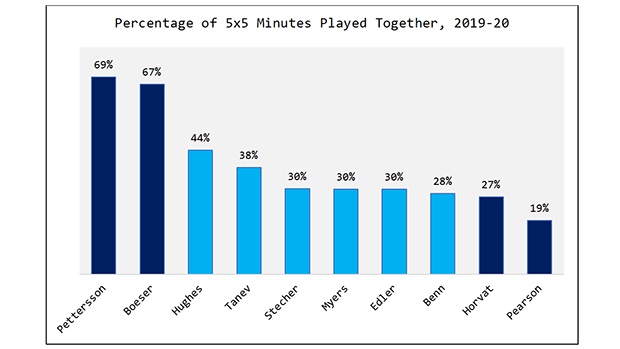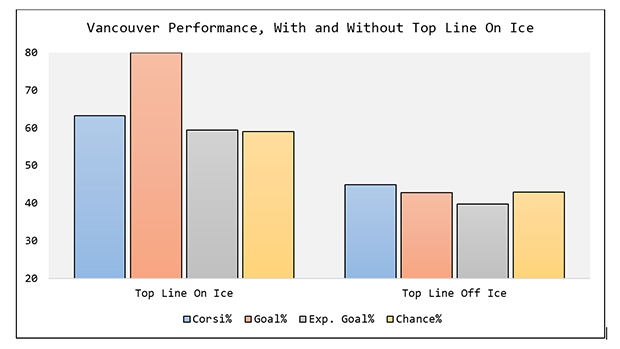Oct 24, 2019
Canucks' top line dominating the competition
Vancouver GM Jim Benning took a big risk in the off-season by trading a conditional first-round pick for J.T. Miller, but the early returns suggest the winger has helped elevate the team’s top line, Travis Yost writes.
By Travis Yost

The Vancouver Canucks drew a lot of attention last summer when they moved multiple draft picks – including a conditional first-rounder in the 2020 NHL Draft – to the Tampa Bay Lightning in exchange for left wing J.T. Miller.
It’s rather unusual for rebuilding teams to move a package of future assets like that, especially when a first-round pick is involved. Front offices tend to take a conservative approach when they trade picks they know could end up as meaningful draft capital, but general manager Jim Benning went in the opposite direction. And for Benning the risk is quite high: Vancouver hasn’t reached the postseason since the 2014-15 regular season, and expectations for this season weren’t particularly high either.
That said, with risk can come reward, and Miller is a valuable asset. The question floating around Vancouver during the off-season concerned where he would be inserted into the lineup, which linemates he would be given, and what type of results the 26-year old could drive within the construct of this Canucks team. The lineup does have star talent – hello Elias Pettersson and Brock Boeser – but sorely lacks the type of depth you need to push into the playoff mix.
The deployment question was answered early. Head coach Travis Green opted to keep his best talents together in an attempt to create a formidable top line. Miller has played an extensive amount of minutes with the two best players on the roster, and it’s given Vancouver some real credibility at the top of their lineup:

From an individual production standpoint, I think it’s fair to say things are humming along for all three of Vancouver’s marquee forwards. Through Thursday, Miller, Pettersson, and Boeser lead the Canucks in scoring, with both Miller (four goals, six assists) and Pettersson (two goals, eight assists) averaging more than a point per game. The overarching team results are also impressive early on – the Canucks have won six of their first nine games and in a division where only the Vegas Golden Knights appear to be a playoff lock, the early standings advantage they hold over the opposition matters.
Let’s talk about this line a bit further. We know the points have been racked up and we know that the team is winning, but is this a fleeting early season shooting percentage surge, or indicative of a line that is dominating the run of play? The answer appears to be the latter – and that’s fantastic news if you’re getting increasingly optimistic about Vancouver’s possible playoff fortunes.
Consider the splits for Vancouver’s performance with and without their top line on the ice. We know the depth issues will haunt this team to some degree, but if the Canucks truly have a capable top line, it completely changes the dynamic of how competitive the team can be. Through the first nine games, Vancouver’s top line has been sterling:

The crazy advantageous goal differential will regress with more minutes played, but the point here is that Vancouver’s top line is utterly dominating the competition. They are consistently getting 60 per cent or more of the shots, scoring chances, and expected goals when they are on the ice – that’s good even in comparison to other first lines around the league, and it’s certainly a night-and-day difference relative to what the rest of the Vancouver lineup can offer.
Vancouver paid a steep price for Miller’s services, and it’s going to take a lot more than two weeks of hockey to change our opinion on whether or not he was worth the price. But it’s this type of performance – even over just a two-week sample – that will give the Canucks’ front office more confidence in what they were trying to accomplish.


